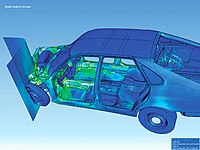
Photo from wikipedia
The paper presents 3D finite element simulation of an SH-SAW delay line sensor to investigate coupled resonance with SiO$$_{2}$$2 micro-ridges designed along the wave propagation direction on a 36$$^{\circ }$$∘-YX LiTaO$$_{3}$$3… Click to show full abstract
The paper presents 3D finite element simulation of an SH-SAW delay line sensor to investigate coupled resonance with SiO$$_{2}$$2 micro-ridges designed along the wave propagation direction on a 36$$^{\circ }$$∘-YX LiTaO$$_{3}$$3 substrate. Time response simulation is used to calculate the displacements and voltages at the output IDT. The device generates a shear wave with horizontal displacement component ten times greater than vertical displacement component. Mass loading is simulated by applying an equivalent surface mass density of double-stranded DNA uniformly on the SiO$$_{2}$$2 ridges. At critical ridge height, both substrate and ridge vibrate in unison leading to a sharp change in the phase shift from negative to positive causing coupled resonance. In the presence of coupled resonance, the device offers high mass sensitivity of 1295 m$$^{2}$$2/kg which is about 20 times greater in comparison to the mass sensitivity of a conventional SiO$$_{2}$$2 based Love wave device. The increase in mass sensitivity at coupled resonance is attributed to the increase in the area-averaged stress at the interface of micro-ridge and substrate, going above 8.5 MPa. As ridge height is varied, a transition occurs in the mode of vibration leading to a 5 dB swing in the insertion loss of the device near the coupled resonant height.
Journal Title: Microsystem Technologies
Year Published: 2018
Link to full text (if available)
Share on Social Media: Sign Up to like & get
recommendations!